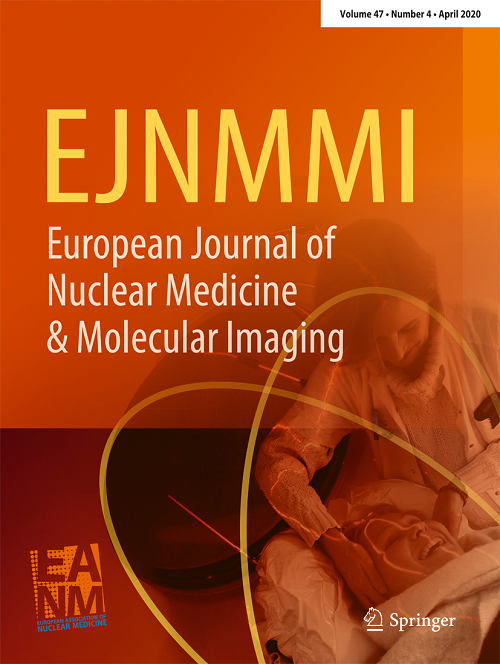[18F]FDG PET/CT for outcome prediction in diffuse large B-cell lymphoma treated with polatuzumab vedotin-containing regimens.
IF 7.6
1区 医学
Q1 RADIOLOGY, NUCLEAR MEDICINE & MEDICAL IMAGING
European Journal of Nuclear Medicine and Molecular Imaging
Pub Date : 2025-09-19
DOI:10.1007/s00259-025-07561-z
引用次数: 0
Abstract
PURPOSE To investigate the prognostic values of 2-deoxy-2-[18F]fluoro-D-glucose positron emission tomography/computed tomography ([18F]FDG PET/CT) in patients with diffuse large B-cell lymphoma (DLBCL) treated with Polatuzumab vedotin (Pola)-containing regimens. MATERIALS AND METHODS Thirty-nine patients who received Pola-containing regimens and underwent pre-treatment [18F]FDG PET/CT were retrospectively enrolled and followed up. Qualitative response was assessed using Lugano criteria on follow up PET. Quantitative [18F]FDG PET parameters including maximum standardized uptake value (SUVmax), mean standardized uptake value (SUVmean), metabolic tumor volume (MTV), and total lesion glycolysis (TLG) were evaluated using two segmentation methods (SUV 4.0 and 41% SUVmax), and changes in these indices (Δvalues) between pre-Pola and first follow-up PET scans were calculated. The prognostic values of PET metabolic parameters, clinical characteristics, and laboratory indicators were evaluated using time-dependent receiver operating characteristic (ROC) curve, and Cox regression analysis. Survival functions were estimated by Kaplan-Meier analysis. RESULTS The median follow-up duration was 17.2 months (range 3.28 months - 26.2 months). During this period, 16 patients (41.0%) experienced progression. Patients with complete metabolic responses (CMR) exhibited superior outcomes than patients with partial metabolic responses (PMR). ROC and Cox analysis demonstrated that MTV and TLG based on SUV 4.0 segmentation showed superior predictive performance than those based on the 41% SUVmax method. Multivariate Cox regression analysis identified SUVmean (P = 0.016, HR = 1.27) and MTV (P = 0.002, HR = 1.01) on first follow-up PET as independent predictors of progression-free survival (PFS). CONCLUSION CMR patients exhibited superior outcomes than PMR patients, and SUVmean and MTV on the first follow-up PET were independent predictors of PFS, suggesting that [18F]FDG PET/CT may play an important role in predicting outcomes of DLBCL patients treated with Pola-containing regimens.[18]FDG PET/CT对弥漫性大b细胞淋巴瘤的预后预测。
目的探讨2-脱氧-2-[18F]氟-d -葡萄糖正电子发射断层扫描/计算机断层扫描([18F]FDG PET/CT)在使用含Pola的Pola单抗治疗弥漫性大b细胞淋巴瘤(DLBCL)患者中的预后价值。材料与方法回顾性入选39例接受含pola方案并进行预处理的FDG PET/CT患者[18F]。采用Lugano标准对随访PET进行定性评价。定量[18F]FDG PET参数包括最大标准化摄取值(SUVmax)、平均标准化摄取值(SUVmean)、代谢肿瘤体积(MTV)和病灶总糖酵解(TLG),采用两种分割方法(SUV 4.0和41% SUVmax)进行评估,并计算这些指标在pola前和首次随访PET扫描之间的变化(Δvalues)。采用时间依赖性受试者工作特征(ROC)曲线和Cox回归分析评估PET代谢参数、临床特征和实验室指标的预后价值。生存函数用Kaplan-Meier分析估计。结果中位随访时间为17.2个月(3.28 ~ 26.2个月)。在此期间,16例患者(41.0%)出现进展。完全代谢反应(CMR)患者的预后优于部分代谢反应(PMR)患者。ROC和Cox分析表明,基于SUV 4.0分割的MTV和TLG的预测性能优于基于41% SUVmax方法的预测性能。多因素Cox回归分析发现首次随访PET的SUVmean (P = 0.016, HR = 1.27)和MTV (P = 0.002, HR = 1.01)是无进展生存期(PFS)的独立预测因子。结论cmr患者预后优于PMR患者,首次随访PET的SUVmean和MTV是PFS的独立预测因子,提示[18F]FDG PET/CT可能在预测含pola方案治疗的DLBCL患者预后方面发挥重要作用。
本文章由计算机程序翻译,如有差异,请以英文原文为准。
求助全文
约1分钟内获得全文
求助全文
来源期刊
CiteScore
15.60
自引率
9.90%
发文量
392
审稿时长
3 months
期刊介绍:
The European Journal of Nuclear Medicine and Molecular Imaging serves as a platform for the exchange of clinical and scientific information within nuclear medicine and related professions. It welcomes international submissions from professionals involved in the functional, metabolic, and molecular investigation of diseases. The journal's coverage spans physics, dosimetry, radiation biology, radiochemistry, and pharmacy, providing high-quality peer review by experts in the field. Known for highly cited and downloaded articles, it ensures global visibility for research work and is part of the EJNMMI journal family.

 求助内容:
求助内容: 应助结果提醒方式:
应助结果提醒方式:


